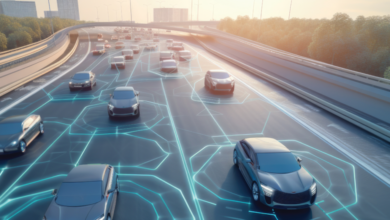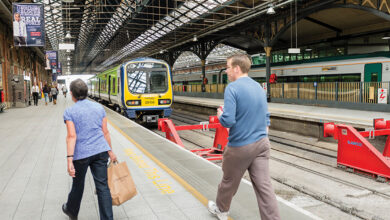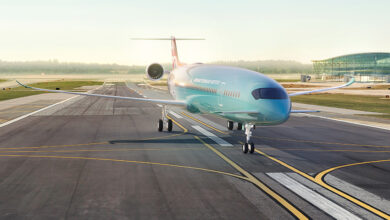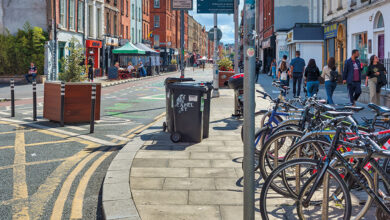Alternative fuels for Europe
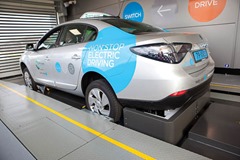 Ireland needs another 22,000 extra electric charging points according to the European Commission’s alternative fuels strategy for transport. eolas examines the plans to reduce the continent’s reliance on imported oil.
Ireland needs another 22,000 extra electric charging points according to the European Commission’s alternative fuels strategy for transport. eolas examines the plans to reduce the continent’s reliance on imported oil.
The Clean Power for Transport package is the European Commission’s strategy for alternative fuels. Published in January, it aims to fix two major problems facing European transport: an insecure energy supply and a high import bill.
Transport is the largest oil consumer, taking up 55 per cent of European consumption. Oil accounts for the vast majority (94 per cent) of transport fuels and 84 per cent of transport-consumed oil is imported.
Europe spent up to €1 billion per day on oil in 2011. Oil prices experienced two major spikes in recent years: €90 per barrel in the 2007-2008 speculative bubble and €40 per barrel during the initial Arab Spring unrest.
The Commission has concluded that different technological choices between member states lead to isolated regional markets, the fragmentation of the internal market for alternative fuels and technology ‘border lines’ which hold back mobility. Its package therefore aims to remove technical and regulatory barriers across the EU and facilitate a genuine single market.
The large-scale deployment of alternative fuels would help to meet the target of cutting transport-related greenhouse gas emissions by 60 per cent between 1990 and 2050. It can also help urban areas to meet air quality standards set by the EU. If the EU acted as a first-mover, the competitiveness of its transport network would also be enhanced with spin-off effects in manufacturing output and job creation.
The package contains three elements:
• a communication (policy proposal) on diversifying fuels away from oil;
• a Directive on the deployment of alternative fuels infrastructure; and
• a staff working document on liquefied natural gas (LNG) for shipping.
The main options for the different modes were liquefied petroleum gas and bio-methane, biofuels, natural gas, electricity and hydrogen. Liquid biofuels and synthetic fuels could technically provide solutions for all transport modes but their supply is limited by the number of feedstock and the potential for increased emissions from biofuels.
Natural gas can fuel most modes, with the exception of air transport. LNG is considered best for medium-haul and long-haul road freight and all forms of maritime transport. Electricity is suitable for railways and short road journeys. Hydrogen is available for road transport (except long-haul freight) and also rail.
The Commission says that the infrastructure package is necessary to increase confidence for investors and consumers. It should provide a stable framework for investment, common standards across the EU and better information for consumers on fuel-vehicle compatibility.
National frameworks
Each of the member states would adopt a national policy framework for the market development of alternative fuels and their infrastructure. This would assess the state and future development of the fuels, and also assess support for infrastructure and whether that infrastructure would work on both sides of a national border.
For each member state, the Directive sets minimum numbers of:
• electric vehicle recharging points;
• CNG refuelling points (not more than 150km apart);
• hydrogen refuelling stations (not more than 300km apart);
• refuelling points for road transport vehicles (not more than 400km apart); and
• LNG refuelling points for ships in major maritime ports and inland ports.
Ireland already has around 800 electric points. A conservative approach, based on its share of urban population, would require Ireland to install another 22,000 electric vehicle chargers by 2020, of which 2,000 would be available for public use.
Six LNG facilities (three for ships and three for freight trucks) would also be built, along with 22 compressed natural gas refuelling stations.
The estimated total cost in Ireland would be €73.4 million, most of which
(€45 million) would be spent on the port facilities. The extra electric vehicle points would cost €22 million and the remaining infrastructure €6.7 million.
Common technical specifications for the infrastructure are to be in place by 2015. ‘Consumer information’ would involve some form of standard diagram or label, to be rolled out at filling stations across the EU.
A comprehensive framework for marine LNG would also be developed by 2015. The EU would also work with relevant international organisations (e.g. the International Maritime Organization) and major non-EU countries to ensure common global standards in this area.
An EU-funded research project has identified four ‘blue corridors’ for building LNG infrastructure across western and central Europe:
1. Ireland-Austria (across the UK, Benelux and Germany);
2. Ireland-Portugal (a loop taking in the UK, France and Spain);
3. Sweden-Portugal (across Germany, France and Spain); and
4. Spain-Croatia (taking in southern France and Italy).
In the Commission’s view, the benefits will “clearly outweigh” the costs of the strategy, estimated at €10.5 billion. It claims that by 2030, the continent could be saving €2.3 billion per year which would otherwise be spent on oil. Improved security of energy supply could add another €1 billion per year of annual savings. The industry would be “ready to invest once they have a strong signal” and new infrastructure would represent a localised investment in growth and jobs.
What next?
Commission proposals on transport policy must be approved by the Council of the European Union (bringing together national governments) and the European Parliament. The alternative fuels strategy will therefore be discussed by the Transport, Telecommunications and Energy Council and the Parliament’s Transport and Tourism Committee over the remainder of this year. Ireland is represented on the Transport and Tourism Committee by Fine Gael MEP Jim Higgins.

